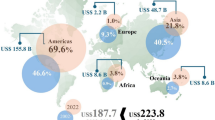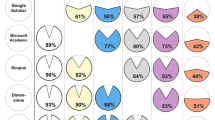Abstract
Time dependence of bibliographic scattering is not at all understood. There are not many studies to establish any relation between growth of a bibliography over time and scattering. In this empirical study three different types of bibliographies have been taken. Each bibliography has been partitioned in different temporal periods (according as the particular bibliography should allow). The complete bibliography and the partitions have then been used to draw corresponding Bradford bibliographs whose natures have been studied. No conclusive relation between growth and scattering could be drawn except that the nature of the bibliograph depends on the value of concentration that is the ratio of the number of items and the number of sources in the bibliography. The paper shows that much needs to be done in this area and partition studies may be a useful technique.
Similar content being viewed by others
References
S. C. Bradford (1934), Sources of information on specific subjects,Engineering, 137, 85–86.
B. C. Brookes (1968), (The) Derivation and application of the Bradford-Zipf distribution,Journal of Documentation, 24, 4, 247–265.
H. S. Sichel (1985), (A) Bibliometric distribution which really works,JASIS, 36, 314–321.
B. C. Bennon (1986), Estimating size and scatter of world physics journal literature,Czechoslovak Journal of Physics, B, 36, 1, 19–22.
K. M. C. Nweke (1989), Bradford's law and the journal titles cited by research scholars in Zoology at the Ibadan University, Nigeria,IASLIC Bulletin 34, 3 97–104.
S. Naranan (1970), Bradford's law of bibliography of science: an interpretation,Nature, 227, 669–671.
A. Avramescu (1980), Theoretical foundation of Bradford's law,IFID, 5, 1, 15–22.
H. S. Sichel (1986), (The) GIGP distribution model with application to physics literature,Czechoslovak Journal of Physics, B, 36, 1, 133–137.
Q. L. Burrell (1989), On the growth of bibliographies with time: an exercise in bibliometric prediction,Journal Documentation, 45, 4, 302–317.
Q. L. Burrell (1988), Modelling the Bradford phenomenon,Journal of Documentation, 44, 1, 1–18.
S. K. Sen (1991), (A) Model for information dynamics and growth. Preprint.
L. Egghe, R. Rousseau (1988), Reflections on a deflection: a note on different causes of the Groosdroop,Scientometrics, 14, 5–6, 493–511.
G. H. Golub, D. F. O'Leary (1987), Some history of the conjugate gradient and Lanczos algorithm (1948–1976). Numerical Analysis Project Manuscript: NA-87-05. Computer Science Department. Stanford University, California.
P. Zunde (1984), Selected bibliography on information theory application to information science and related subject areas,IP & M, 20, 417–497.
K. K. Gangopadhyay (1988), Bibliography on earthquakes in India. Geological Survey of India,Miscellaneous Publication, 60, Calcutta, 135 p.
S. K. Subir, S. K. Chatterjee, S. K. Gan (1992), Making bibliographic scattering studies useful: significance of Zero item (empty) and single item sources,Informetrics '91,I. K. Ravichandra Rao (Ed.), Sarada Ranganathan Endowment Trust, Bangalore.
S. K. Sen, S. K. Chatterjee (1995), Mean relative scatter (MRS)-a linear equation for bibliometric distributions, further empirical tests,Proc. Fifth International Conference of the ISSI,M. E. D. Koenig, A. Bookstein (Eds),Learned Information, Medford, 1995, p. 505.
H. J. Czerwon (1986), Monte Carlo simulations in lattice field theories: publication output and citation impact,Czechoslovak Journal of Physics, B, 36, 1, 33–38.
Author information
Authors and Affiliations
Rights and permissions
About this article
Cite this article
Sen, S.K., Chatterjee, S.K. Bibliographic scattering and time: An empirical study through temporal partitioning of bibliographies. Scientometrics 41, 135–154 (1998). https://doi.org/10.1007/BF02457974
Received:
Issue Date:
DOI: https://doi.org/10.1007/BF02457974




